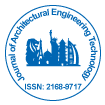Innovative Building Design in Architectural Engineering: Balancing Aesthetics, Functionality, and Sustainability
*Corresponding Author: Dr. Arjun Mehta, Department of Architectural Engineering, National Institute of Architecture and Design, India, Email: arjun.me@gmail.comReceived Date: May 01, 2025 / Accepted Date: May 31, 2025 / Published Date: May 31, 2025
Citation: Arjun M (2025) Innovative Building Design in Architectural Engineering:Balancing Aesthetics, Functionality, and Sustainability. J Archit Eng Tech 14: 461.
Copyright: © 2025 Arjun M. This is an open-access article distributed under theterms of the Creative Commons Attribution License, which permits unrestricteduse, distribution, and reproduction in any medium, provided the original author andsource are credited.
Abstract
Building design in architectural engineering is a multidimensional discipline that integrates art, science, and technology to create structures that are not only visually appealing but also functional, safe, and sustainable. This article explores the evolution, principles, and modern practices in building design from the architectural engineering perspective. It delves into the essential components that make a building design effective from structural integrity and environmental efficiency to space optimization and user comfort. Furthermore, the paper addresses how technological advancements such as Building Information Modeling (BIM), parametric design, and sustainable construction materials are reshaping contemporary architectural practices. By examining real-world case studies and emerging global trends, this article aims to provide a comprehensive understanding of the future trajectory of building design within architectural engineering. The evolution of architectural engineering has witnessed a significant transformation in recent decades, marked by the integration of innovation in building design. This progress is primarily driven by the growing demand for structures that are not only aesthetically appealing but also functional and environmentally sustainable. This abstract highlights the emerging trends, principles, and technologies that are shaping innovative building designs today. Architects and engineers are increasingly adopting interdisciplinary approaches that merge artistic creativity with engineering precision, while also addressing environmental challenges. The integration of advanced materials, smart technologies, and passive design strategies has paved the way for buildings that respond to climate conditions, optimize energy usage, and enhance occupant well-being. Furthermore, the synergy between architectural aesthetics and structural functionality is becoming more pronounced as professionals strive to create iconic and efficient structures. This paper critically examines case studies and design frameworks that exemplify this balance and provides insights into how innovative thinking and sustainable practices are reshaping the future of architecture. Ultimately, the research calls for a paradigm shift in architectural education and practice to foster creativity, responsibility, and resilience in the built environment.

 Spanish
Spanish  Chinese
Chinese  Russian
Russian  German
German  French
French  Japanese
Japanese  Portuguese
Portuguese  Hindi
Hindi 
